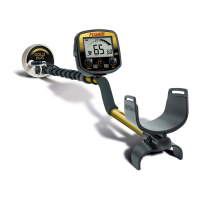7
30
A 3-segment battery indicator at the bottom of the display indicates the
battery condition.
The detector requires a single 9-volt ALKALINE battery.
Do not use ordinary zinc carbon batteries.
Do not use “Heavy Duty” batteries.
Rechargeable batteries can also be used.
If you wish to use rechargeable batteries, we recommend using a
Nickel Metal Hydride rechargeable battery.
The battery compartment is located on the back side of the housing.
Slide the battery door to the side and remove it to expose the battery
compartment.
BATTERY LIFE
Expect about 15 to 20 hours of life from a 9-volt alkaline battery.
Rechargeable batteries can provide up to 8 hours of usage per charge.
SPEAKER VOLUME AND BATTERY CHARGE
You may notice the speaker volume drop when only one battery segment is
illuminated.
With one segment flashing, low speaker volume will be very apparent.
BATTERY INDICATOR
The 3-segment battery indicator has 3 stages of indication.
These indications are accurate for a 9-volt alkaline battery.
Segments Illuminated Battery Voltage
3 -segments more than 8.5 volts
2 -segments more than 7.5 volts
1 -segment flashing more than 6.8 volts
After the 1st segment begins flashing, expect the detector to shut off within 10
minutes.
A rechargeable battery will usually illuminate two to three segments
throughout most of its useful charge. But as soon as it drains to the 1-segment
level, it will then lose its charge very rapidly.
BATTERIES
ELECTRICAL INTERFERENCE (EMI)
You are likely to encounter electrical interference when using your Gold Bug metal
detector. It is important that you recognize electrical interference and take appropriate
measures to deal with it. This will prevent you from giving up on a worthwhile search
site, or from returning a properly functioning detector for repair.
Symptoms of electrical interference
Electrical interference can cause a metal detector to chatter spontaneously, to lose sensitivity
for no apparent reason, or to cause a periodic wobbly audio sound. What you hear will
depend on what operating mode you are using, the detector’s settings, and the source of the
electrical interference. The most common manifestation is spontaneous chatter.
All metal detectors are susceptible to electrical interference, but they vary in what kinds
of electrical interference affect them. In a given environment some metal detectors may
be affected by electrical interference whereas others may not.
Common sources of electrical interference
Common sources of electrical interference include: overhead electric power lines,
underground power lines, other metal detectors, telephone lines carrying electronic
data, computer systems, electric fences, old CRT-based televisions, cell phones, CB
and emergency communication radios, thunderstorms, fluorescent lights, metal vapor
lamps, military aircraft with electronic warfare countermeasures turned on, electric
motors, VLF military communications systems and automobile ignition systems. At
home, in a store, or in an urban environment, there may be several different sources of
electrical interference present simultaneously.
All metal detectors generate a certain amount of internal electronic noise. The Gold Bug
is specifically designed to enable you to work into the noise. Experienced users, striving
for maximum depth, often adjust the machine to search with a constant audible
background sound, and then listen through that noise for the sound of real targets.
Stricter regulations in recent years have cut down on interference from electric light
dimmers and auto ignition systems. However there has also been a proliferation of
VLF-UHF wireless communication systems (cell phones, Bluetooth, wi-fi, etc.), which
often affect metal detectors. Overall, the potential for electrical interference is greater
than it was just a few years ago.
Modern high-end metal detectors are a lot more sensitive than older units; this also
increases your detector’s vulnerability to electrical interference beyond what you may
be accustomed to with an older detector. Metal detectors are by their nature designed
to detect magnetic fields, and electric current always produces magnetic fields.
Coping with electrical interference
The primary reason metal detectors provide a sensitivity (gain and/or threshold) control,
is so that users can reduce sensitivity in order to eliminate response to electrical
interference. Some users are reluctant to reduce sensitivity out of fear of losing depth.
At reduced sensitivity settings, you may lose some depth, but at least you can still
search.
The Gain and Threshold knobs control the sensitivity and are your first

